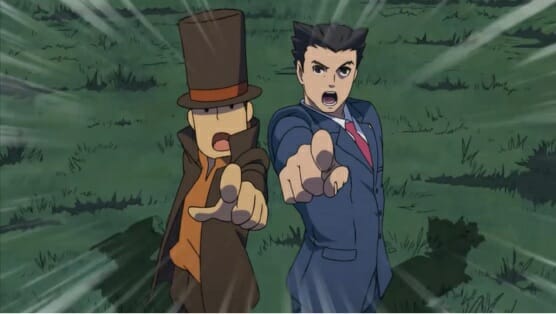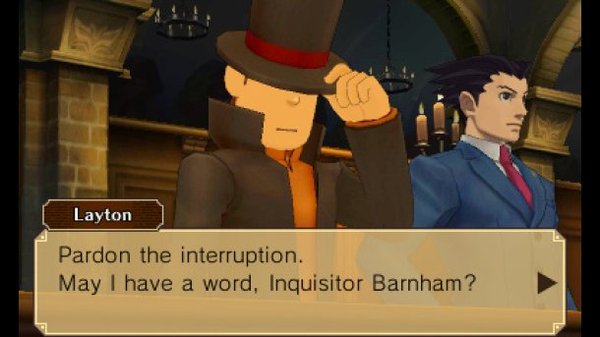Professor Layton vs. Phoenix Wright: Ace Attorney (3DS)

The crossover is a curious phenomenon, most often used in comics when one book’s heroes mix with those of another’s. It smacks of panic: What else can we do with these characters? Like the chef de cuisine concocting a Sunday Brunch menu with Friday’s unsold special (“Pork Chop Omelette!”), a writer or designer can be seen as lazily mashing together ideas in the hope that something great or unexpected occurs. When Level-5 and Capcom first announced this union, I admit I had my doubts. But sometimes pork tastes better in the morning.
The Professor Layton series is half-detective visual novel, half riddle collection. Phoenix Wright is the most popular character in a larger series of Ace Attorney games, another visual novel series wrapped in interactive courtroom drama. On paper each are cultural anomalies. Layton borrows an aesthetic from French animation, though most of the narratives are set in the English countryside. Wright takes cues from Japanese anime yet is located somewhere with a very American-type legal system. A company’s financial advisor might scoff at each character’s limited appeal. Yet Ace Attorney games have appeared on handheld systems since the Game Boy Advance, finally coming to iOS last year. And the Layton series has sold upwards of 15 million copies worldwide.
At a macro level, a crossover game between these two worlds makes almost zero sense. Zoom in though and the similarities are obvious: the strapping lead character, the solving of human dilemmas, the pointing. Both titles have found a level of success rare to quirky character studies that would fit in more naturally as a TV series on BBC or Comedy Central than as a videogame. But only when seeing these two types of play combined have I fully understood why they have remained popular for so long, why these franchises are such a compelling—and indeed, important—aspect of today’s gaming landscape, and what is gained by combining two games that, separately, already work just fine.
The biggest advantage is not what is added but what has been taken away. By splitting two lengthy titles into a single game, with each type of play interspersed throughout, Capcom has turned what can be a repetitive slog into an experience that refreshes itself every hour or two. Past Layton or Wright titles can become a bit samey toward the end, regardless of whatever wacky plotlines have unravelled into absurdity. You’re still just solving puzzles or finding contradictory evidence. But playing Layton vs. Wright is more like switching between two separate games.
In fact, the whole thing has an Epcot feel to it; instead of walking from a fake Germany to a fake Italy, you move through a representation of these two games. Animatronic characters repeat the same motions over and over. A snooty know-it-all named Allen takes his glasses off, snaps them in two, then throws them over his shoulder before placing a new pair on his face. He will do this two or three times during a single conversation. The man must have a good vision plan. Another guy named Tuggit pulls on his long beard until it snaps back like a cartoon window shade. Mary strokes her goat until it baa’s (though it looks an awful lot like a lamb).
Layton games have always used its townspeople as puzzle distributors more than complex characters. Their development is limited to a few visual gags and helpful advice that keeps you moving through the story. Wright’s mix of defendants, prosecutors and witnesses act similarly, each a wonky gear turning in some Rube Goldberg machine devised by Matlock on good, if expired, drugs.
The real fun begins when the characters stop to show up in each others’ chapters; I won’t spoil the surprise, but each merits their inclusion. There’s a tonal dissonance that occurs, highlighting the sweetly serious nature of our tall-hatted detective, and the goofy melodrama of our spiky-haired attorney. (If Professor Layton vs. Phoenix Wright were a movie from the 1960s, a smart casting agent would have chosen Peter Sellers to play both.)
You can even hear the shift in the sound effects. While moving through a Layton section, click on a shimmery puddle in the distance and hear the elegant “bling!” of a picked-up Hint Coin. Once you return to Wright’s courtroom, even subtle shifts in conversation result in “SCH-BANG!” sound cues. It’s hard not to identify elements in the game as originating from one or the other; the lack of continuity can be distracting.
When you’re not talking to strangers or cross-examining witnesses, each style of play includes a kind of scenery investigation. Your stylus controls a magnifying glass; sweep it across the environment to find clues or unearth Hint Coins to be used during challenging tasks. Clicking and scanning the scenery quickly becomes addictive, a kind of Hidden Object mini-game with less of the stigma.
Click on a chandelier and a word bubble pops up with Layton or Luke’s commentary: I wonder how they light those candles? Click it again and the other responds: They likely use a long stick from the second-floor balcony. For some reason I’d spend a majority of my time seeking out these diversions. Rarely would they help solve a puzzle or push the narrative forward. These were just overheard thoughts amongst friends.
